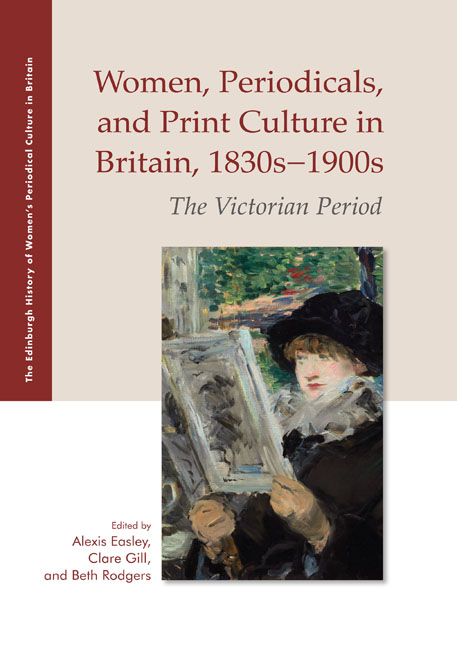Book contents
- Frontmatter
- Contents
- List of Illustrations
- Acknowledgments
- Introduction: Women, Periodicals, and Print Culture in the Victorian Period
- Part I (Re)Imagining Domestic Life
- Part II Constructing Modern Girls and Young Women
- Part III Women and Visual Culture
- Women and Visual Culture: Introduction
- 13 Vicarious Pleasures: Photography, Modernity, and Mid-Victorian Domestic Journalism
- 14 Beauty Advertising and Advice in the Queen and Woman
- 15 Women of the World: The Lady's Pictorial and Its Sister Papers
- 16 Rewriting Fairyland: Isabella Bird and the Spectacle of Nineteenth-Century Japan
- 17 Victorian Women Wood Engravers: The Case of Clemence Housman
- Part IV Making Space for Women
- Part V Constructing Women Readers and Writers
- Part VI Intervening in Political Debates
- Notes on Contributors
- Index
- Plate section
17 - Victorian Women Wood Engravers: The Case of Clemence Housman
from Part III - Women and Visual Culture
Published online by Cambridge University Press: 25 October 2019
- Frontmatter
- Contents
- List of Illustrations
- Acknowledgments
- Introduction: Women, Periodicals, and Print Culture in the Victorian Period
- Part I (Re)Imagining Domestic Life
- Part II Constructing Modern Girls and Young Women
- Part III Women and Visual Culture
- Women and Visual Culture: Introduction
- 13 Vicarious Pleasures: Photography, Modernity, and Mid-Victorian Domestic Journalism
- 14 Beauty Advertising and Advice in the Queen and Woman
- 15 Women of the World: The Lady's Pictorial and Its Sister Papers
- 16 Rewriting Fairyland: Isabella Bird and the Spectacle of Nineteenth-Century Japan
- 17 Victorian Women Wood Engravers: The Case of Clemence Housman
- Part IV Making Space for Women
- Part V Constructing Women Readers and Writers
- Part VI Intervening in Political Debates
- Notes on Contributors
- Index
- Plate section
Summary
TWENTIETH-CENTURY PRINTMAKER Leonard Baskin produced a limited edition of Icones Librorum Artifices: Being Actual, Putative, Fugitive & Fantastical Portraits of Engravers, Illustrators & Binders at his Gehenna Press in 1988. In this tribute to book artists across the centuries, Baskin celebrates Clemence Housman (1861–1955) as a ‘professional reproductive wood engraver’ (1988). Baskin's ‘fantastical’ portrait of Housman shows an upturned face in profile, marked by strong features and wild auburn hair (Figure 17.1). Rather than aiming at mimetic likeness, the symbolic colour etching pays homage to Housman's Pre-Raphaelite roots and her feminist activism: the fierce smile emerging from the tousled locks seems to reify Hélène Cixous's ‘laugh of the Medusa’ (1976). Under the head, the lines forming the biographical note create a chalice shape, illuminating Baskin's praise of Housman's ‘engravings … [as] marvels of clarity and beauty’ (1988). The textual container seems a deliberate reference to the ‘crystal goblet’ theory of twentieth-century printers, which held that readers should be able to drink in the revealed message by seeing through ‘transparent’ printed marks (Gutjahr and Benton 2001: 2). The crystal goblet theory of modern typography rests on the same premise as the Victorian concept of facsimile wood engraving, where the lines cut into the block were to serve the image invisibly, ostensibly revealing only the artist's drawing. What made Clemence Housman one of the most skilled engravers of her day has also worked to make her virtually invisible in the history of print. ‘Her self-effacement,’ as printer James Guthrie remarked with approbation, ‘is complete’ (1924: 192).
Victorian wood engravers continue to be largely invisible in current scholarship, including research focused on women and the press. In Unseen Hands: Women Printers, Binders, and Book Designers, a Princeton exhibition catalogue that includes Baskin's tribute to Housman, curator Rebecca W. Davidson observes, ‘Each woman featured in … [the] exhibition stands in for thousands of her sisters, known and unknown, who have loved books and printing, and gotten on with the work’ (2003). This chapter aims to shine a light on the unseen labour of Victorian women wood engravers. I take Clemence Housman as my case study in the hope that she may stand in for her wood-engraving sisters, known and unknown.
- Type
- Chapter
- Information
- Women, Periodicals and Print Culture in Britain, 1830s–1900sThe Victorian Period, pp. 277 - 300Publisher: Edinburgh University PressPrint publication year: 2019



